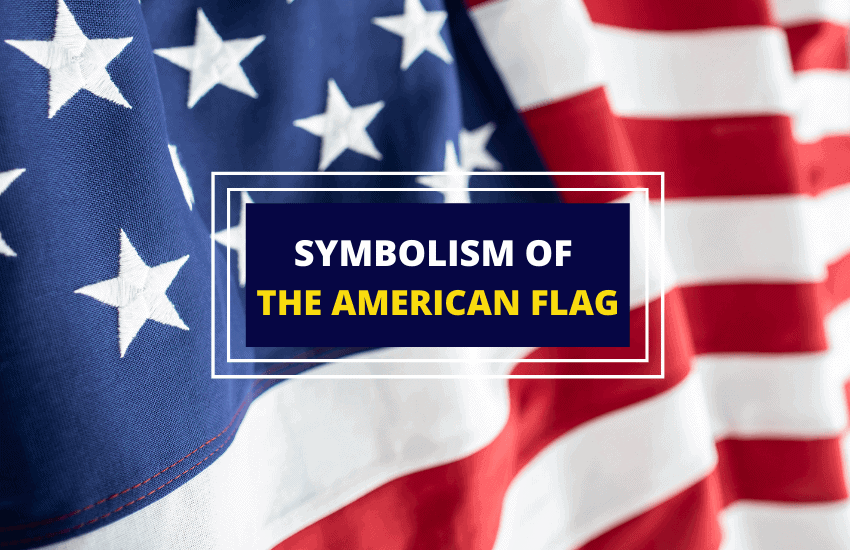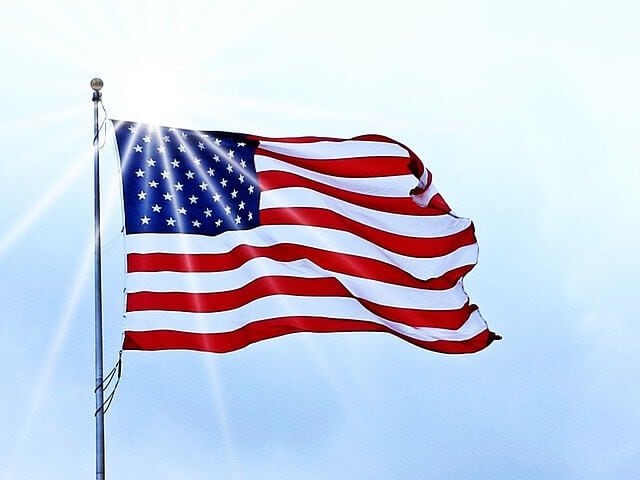
Table of Contents
The famous US flag goes by many names – The Red, The Stars and Stripes, and the Star-Spangled Banner are just a few of them. It’s one of the most distinct flags among all countries, and even inspired the US national anthem. With over 27 versions, some of them flowing for only a year, the Stars and Stripes perfectly symbolizes the rapid growth of the US nation throughout history.
Different Versions of the American Flag
The US flag has significantly evolved over the years. As one of America’s most important national symbols, different versions of it have become crucial historical artifacts, reminding its people of how key events shaped their nation. Here are a couple of its most popular and esteemed versions.
The First Official US Flag
The first official flag of the United States was approved by the Continental Congress on June 14, 1777. The resolution decreed that the flag would have thirteen stripes, alternating between red and white. It also declared that the flag would have thirteen white stars against a blue field. While each stripe represented the 13 colonies, the 13 stars represented each state of the US.
There were issues with the Resolution though. It did not clearly specify how the stars should be arranged, how many points they would have, and whether the flag should have more red or white stripes.
Flag makers made different versions of it, but Betsy Ross’s version became one of the most popular. It featured 13 five-pointed stars forming a circle with the stars pointing outwards.
The Betsy Ross Flag
While there are ongoing debates on the exact origin of the American flag, some historians believe that it was first designed by New Jersey Congressman Francis Hopkinson and sewn by Philadelphia seamstress Betsy Ross in the late 1770s.
However, there is some doubt that Betsy Ross made the first US flag. William Canby, Besty Ross’s grandchild, claimed that George Washington walked into her shop and asked her to sew the first American flag.
The Pennsylvania Historical Society disagrees, stating that there is little evidence to support Canby’s version of events and considering it more of a myth rather than a historical fact.
The Tale of the Old Glory
Another version of the US flag that has become an important Civil War artifact was William Driver’s Old Glory. He was a sea merchant who decided to go on an expedition in 1824. His mother and some of his admirers created a giant 10- by 17-foot American flag, which he flew high above his ship named Charles Doggett. He used it to express love for his country, flying it high and proud across the South Pacific throughout his 20-year career as a sea captain.

Driver’s expeditions were cut short when his wife became ill. He then remarried, had more children, and moved to Nashville, Tennessee, bringing the Old Glory along and flying it once again in his new home.
As the United States acquired more territories and continued to grow, Driver decided to sew additional stars onto the Old Glory. He also sewed a small anchor onto its lower right side as a remembrance of his career as a captain.
Being the staunch Unionist that he was, William Driver stood his ground when southern Confederate soldiers asked him to surrender the Old Glory. He went as far as to say that they’d have to take the Old Glory over his dead body if they wanted to have it. He eventually asked some of his neighbors to make a secret compartment in one of his quilts where he ended up hiding the flag.
In 1864, the Union won the Battle of Nashville and put an end to the Southern resistance in Tennessee. William Driver finally took the Old Glory out of hiding and they celebrated by flying it high above the state capitol.
There is some debate on where the Old Glory is right now. His daughter, Mary Jane Roland, claims that she inherited the flag and gave it to President Warren Harding who then turned it over to the Smithsonian Institution. In that same year, Harriet Ruth Waters Cooke, one of Driver’s nieces, stepped forward and insisted that she had the original Old Glory with her. She gave her version to the Peabody Essex Museum.
A group of experts analyzed both flags and ruled that Roland’s flag was probably the original version because it was much larger, and it had more signs of wear and tear. However, they also deemed Cooke’s flag an important Civil War artifact, concluding that it must have been Driver’s secondary flag.
The Symbolism of the US Flag

Despite the conflicting accounts about the history of the US Flag, it has proven to be a great representation of the United States’ rich history and its people’s admirable fight for civil rights. Every version of the flag was made with careful thought and consideration, with elements and colors that perfectly capture true American pride.
Symbolism of the Stripes
The seven red and six white stripes represent the 13 original colonies. These were the colonies that rebelled against the British Monarchy and went on to become the first 13 states of the Union.
Symbolism of the Stars
To reflect the United States’ steady growth and development, a star was added to its flag every time a new state was added to the Union.
Because of this constant change, the flag has had 27 versions to date, with Hawaii as the last state to join the Union in 1960 and the last star added to the US flag.
Other American territories like Guam, Puerto Rico, the US Virgin Islands, and others, may also be considered for statehood and eventually be added to the US flag in the form of stars.
Symbolism of Red and Blue
While the stars and the stripes in the US flag represented its territories and states, its colors appear to have had no specific meaning when it was first adopted.
Charles Thompson, the Secretary of the Continental Congress, changed all this when he assigned a meaning to each color in the Great Seal of the United States. He explained that the color red signified valor and hardiness, white symbolized innocence and purity, and blue conveyed justice, perseverance, and vigilance.
Over time, his explanation eventually became associated with the colors in the American flag.
The American Flag Today
With Hawaii joining the Union as the 50th state on August 21, 1959, this version of the US flag has flown for over 50 years. This is the longest time that any US flag has ever flown, with 12 presidents serving under it.
From 1960 to the present, the 50-star US flag has become a staple in government buildings and commemorative events. This led to the enactment of several regulations under the US Flag Act, which were designed to preserve the banner’s sacred status and symbolism.
These rules include displaying it from sunrise to sunset, raising it fast and lowering it slowly, and not flying it during inclement weather.
Another rule states that when the flag is displayed in a ceremony or a parade, everyone except those who are in uniform should face it and put their right hand over their heart.
In addition, when it is displayed flat against a window or wall, the flag should always be positioned upright with the Union placed on the left uppermost side.
All of these rules are in place to give clear expectations of how the American people should pay tribute to the American flag.
Myths About the US Flag
The long history of the US flag has led to the evolution of interesting stories attached to it. Here are some interesting tales that have stuck around over the years:
- American citizens didn’t always fly the US flag. Before the Civil War, it was customary for ships, forts, and government buildings to fly it. Seeing a private citizen flying the flag was considered strange. This attitude toward the US flag changed when the Civil War began, and people started displaying it to express their support for the Union. Today, you’ll see the American flag flying above many homes in the US.
- Burning the US flag is no longer illegal. In the case Texas v. Johnson in 1989, the Supreme Court passed a ruling which stated that desecrating the flag was a form of free speech protected by the First Amendment. Gregory Lee Johnson, an American citizen who burned the US flag as a sign of protest, was then declared innocent.
- Based on the Flag Code, the US flag should never touch the ground. Some believed that if the flag touched the ground, it needed to be destroyed. This is a myth though, as flags only need to be destroyed when they are no longer fit for display.
- While the Department of Veterans Affairs customarily provides the US flag for the memorial service of veterans, it doesn’t necessarily mean that only veterans can have the flag wrapped around their casket. Technically, anyone can cover their casket with the US flag as long as it isn’t lowered down into the grave.
Wrapping Up
The history of the US flag is just as colorful as the history of the nation itself. It continues to fuel the American people’s patriotism, serving as a symbol of national pride and identity. Depicting unity across all 50 states and showcasing its people’s rich heritage, the US flag remains a sight to behold for many.








